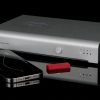To get a better understanding of this subject, take a look at the AC plugs on some of your audio-video gear, new and old, and on some appliances in your home. You’ll notice that some may have a 3-prong plug, others a 2-prong plug with one prong larger (polarized) than the other, and still others with two prongs the same size. The latter can be inserted either way into a standard AC outlet.
Those variations serve as a textbook example of how grounding standards have changed over the decades and why, if you have a stereo or home theater setup that typically involves interconnection of various components, you may have experienced the persistent irritations of a “ground loop,” which produces annoying low-frequency hums and buzzes from your speakers and/or subwoofer and may even introduce curious patterns of interference into television pictures.
Some Basics
When we say “ground” we also mean “earth,” but from an electrical point of view, unless we step outside, the closest we get to a real earth ground is one of the prongs on an AC plug in the wall. In an older house or apartment that doesn’t have PVC (plastic) plumbing, the cold-water tap may lead to copper or lead pipe that eventually reaches true earth. When you stick a metal pipe into the ground in the context of an electrical circuit, the ground should have zero electric potential. If you put a voltmeter on it, you may get a fraction of a volt but it should be close to zero. But if you connected the voltmeter to the ground pin of an AC outlet in your home and to earth, depending on the competence of the electrician who wired your home, you might get a significant voltage differential in the reading, perhaps even a volt or two. It’s that voltage difference that will introduce ground loops and hum when you string together a number of components that may use different grounding systems. Adding to that are the different electrical potentials of the grounding shield from cable-TV distribution and satellite-TV installations.
Floating Ground
Electrical circuits, however, don’t necessarily have to be connected to a true earth ground; they may operate with a kind of “floating” ground. In fact, for the designer and engineer, the sense of “ground” may just become an intellectual convenience. For example, a flashlight and other battery-operated devices–even your car–work perfectly well without being connected to a true earth ground. In a car, the negative battery post and the chassis frame serve as the “ground” to complete the electrical circuits in the car, yet the entire car is insulated from the real earth by the rubber tires. In fact, the car is a good example of a self-contained electrical system tied to a common ground–the car chassis and the negative battery terminal. All the electrical devices on the car are tied to that common ground path through the metal car frame and body.
So within one system–say an AV receiver–the ground path may be tied to the chassis and one of the prongs on the AC plug or the third prong an a 3-prong plug, or it may not, in which case it could use an internal “floating” ground that’s not connected to the chassis.
History of Plugs ‘n’ Prongs
A little history helps explain grounding incompatibilities. Back in the 1950s and early 1960s when hi-fi was invented in the USA, North America had not yet switched to a 3-prong grounding system or even a polarized 2-prong plug. In the 1970s and ’80s, as Japan became a powerhouse in hi-fi, manufacturing and design moved away from the US, and because Japan was still on a 2-prong unpolarized AC plug and remained that way for decades, most manufacturers used an isolated ground system that wasn’t tied to the AC plug. That way a designer could also get improved signal-to-noise performance.
Three Prongs
When North America converted to a 3-prong grounding system, this was viewed as a good thing, provided the electrician wired your house and AC sockets properly. The 3-prong plug offered the possibility of a common ground path between all interconnected components, so long as all the components used the 3-prong plug. But as we know, that wasn’t the case: prior to the introduction of the 3-prong and polarized 2-prong AC plugs, manufacturers isolated the ground system within the component. Even the power supply for the audio circuits “floated”. In more modern components such as Axiom’s A1400-8 multi-channel amplifier, a “STAR” ground is used, whereby all grounds within the amplifier come back to a central ground that is tied to the center prong of the 3-prong plug. That’s all well and good, except within many AV receivers, the front main channel grounds are isolated from the surround-channel grounds. If an AV receiver’s pre-outs are connected with unbalanced RCA connectors to a 3-prong power amplifier, hum will likely result because of the lack of a common grounding path. Using balanced XLR connectors would eliminate all these problems, but only a few more expensive AV preamp-processors are equipped with balanced XLR connectors and, according to Tom Cumberland, Axiom’s chief R&D engineer, AV receiver manufacturers are unlikely to switch.
The good news is that Axiom’s Tom, along with other prominent and experienced engineers within the Consumer Electronics industry, now sits on Consumer Electronics Association panels to try and bring some standardization to the industry.
I’ve left out references to input and output impedances from this discussion, another source of wide variability in design standards that leads to problems in component compatibility. It’s a dense subject best left to a separate future discussion.
(bio), Axiom Audio





























